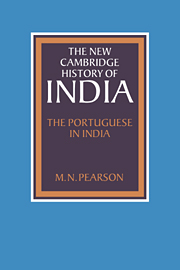5 - Catholics and Hindus
Published online by Cambridge University Press: 28 March 2008
Summary
The preceding chapter focussed on Goa in the sixteenth century. It excluded, except in passing, any discussion of religious interaction in Portuguese India. This forms the subject of the present chapter, which makes both a topical and chronological link with all the previous discussion. Again it shows interaction as well as unidirectional influence, but it also leads to our ensuing study of Portuguese India in its long decline, for this chapter makes no attempt to restrict itself to the sixteenth century.
Leaving aside official statements by Portuguese kings and twentieth-century apologists, who put religious activities in the forefront of their presence in Asia, one can see a general trend in Portugal's attention to conversions. The early years were rather slack and tolerant, but from 1540 the arrival in Goa of the ideology of the Counter Reformation, and its shock troops the Jesuits, increased the tempo and pressure very considerably. But this verve later came to slacken, and be tempered by political realities. Again then we see the need to be very precise when we assess the Portuguese impact on India; it varied widely over both time and space particularly in the category of religion.
The early years are especially interesting, for they were dominated by a very human, and humane, desire to find familiar things in Asia. This explains da Gama's well-known failure, during three months in Malabar, to understand that Hinduism was different from Christianity. True, the images in the temples seemed somewhat grotesque, and some practice clearly unusual or even schismatic: nevertheless the non-Muslim inhabitants of Malabar appeared to be some sort of Christians.
Keywords
- Type
- Chapter
- Information
- The Portuguese in India , pp. 116 - 130Publisher: Cambridge University PressPrint publication year: 1988

